It looks like you're using an Ad Blocker.
Please white-list or disable AboveTopSecret.com in your ad-blocking tool.
Thank you.
Some features of ATS will be disabled while you continue to use an ad-blocker.
share:
Could this be one of the dark secrets of history and archaeologists don't talk about it?.
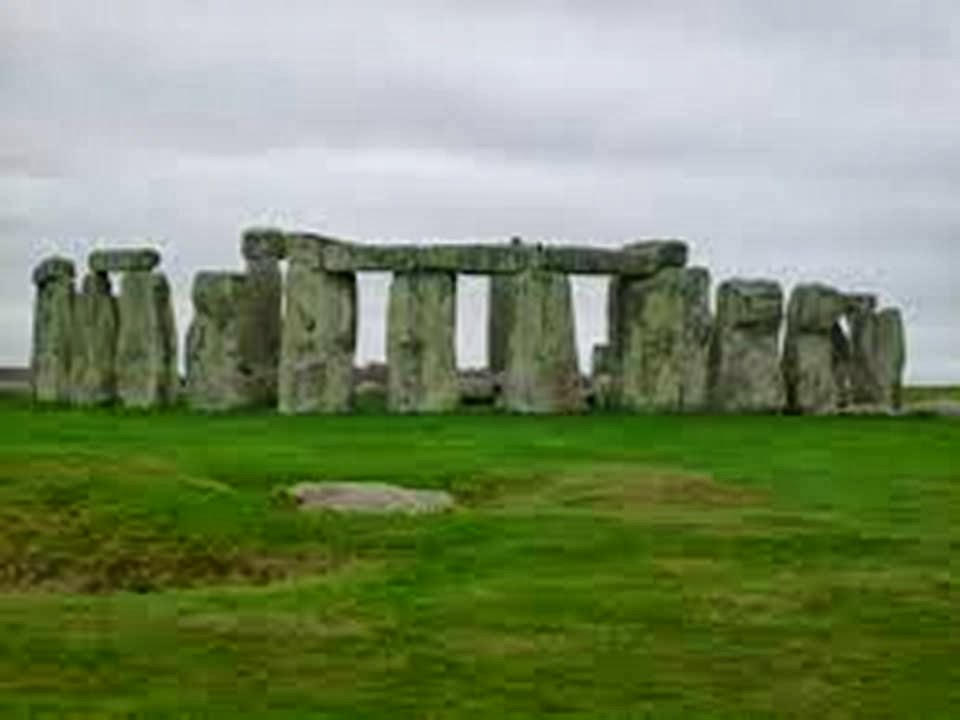
What we see is not the creation of prehistoric people but it has been created by the heritage industry.
For decades the official Stonehenge guidebooks have been full of fascinating facts and figures and theories surrounding the world's greatest prehistoric monument. What the brochures do not mention, however, is the systematic rebuilding of the 4,000 year old stone circle throughout the 20th Century. The information is markedly absent from the guidebooks and info-phones used by tourists at the site.
The Stonehenge makeover was carried out from 1901 to 1964 - (1901, 1919, 1920, 1954 to 1958 and 1964.)
Now, a Russian website shows stunning photos of what appears to be Stonehenge rebuilt in the years 1954 to 1958.
Here are some of the stunning photo's provided by the Russian website:
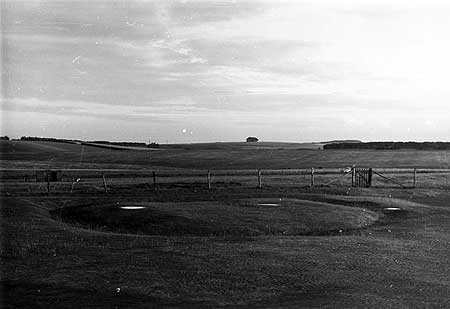
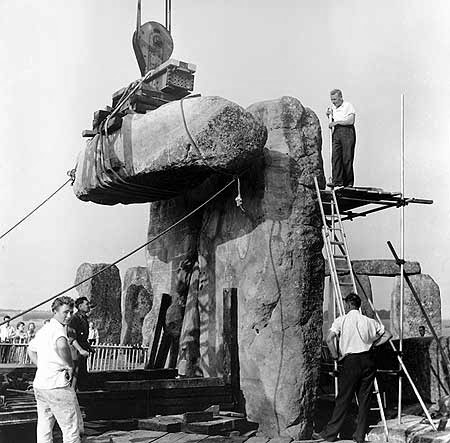


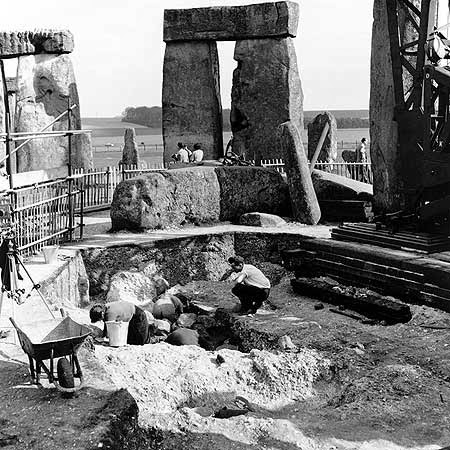
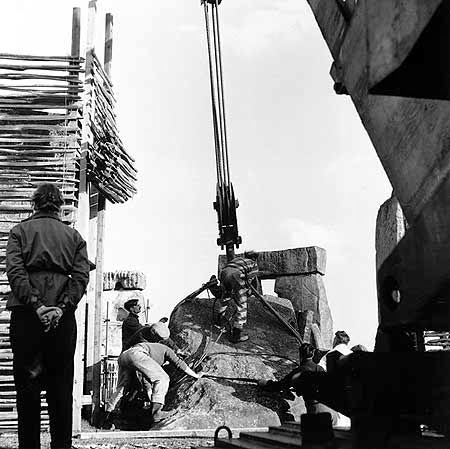
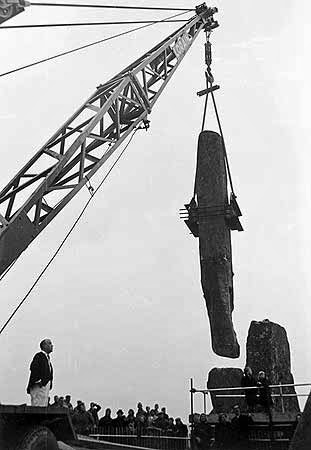
plenty more photos here: PHOTOS and LINK to russian website.
I also found this site: How they rebuilt Stonehenge
Furthermore, the Russian author provides detailed information about how the British government/military rebuilt the Stonehenge site. (Use Google translate if you visit the Russian site.)
So despite the photo's appear to be authentic, the question remains: Stonehenge is rebuilt and the photographs are evidence of the makeover?, or the photos show a replica, built at a different location?.

What we see is not the creation of prehistoric people but it has been created by the heritage industry.
For decades the official Stonehenge guidebooks have been full of fascinating facts and figures and theories surrounding the world's greatest prehistoric monument. What the brochures do not mention, however, is the systematic rebuilding of the 4,000 year old stone circle throughout the 20th Century. The information is markedly absent from the guidebooks and info-phones used by tourists at the site.
The Stonehenge makeover was carried out from 1901 to 1964 - (1901, 1919, 1920, 1954 to 1958 and 1964.)
Now, a Russian website shows stunning photos of what appears to be Stonehenge rebuilt in the years 1954 to 1958.
Here are some of the stunning photo's provided by the Russian website:







plenty more photos here: PHOTOS and LINK to russian website.
I also found this site: How they rebuilt Stonehenge
Furthermore, the Russian author provides detailed information about how the British government/military rebuilt the Stonehenge site. (Use Google translate if you visit the Russian site.)
So despite the photo's appear to be authentic, the question remains: Stonehenge is rebuilt and the photographs are evidence of the makeover?, or the photos show a replica, built at a different location?.
edit on 21-12-2013 by skyblueworld because: (no reason given)
reply to post by skyblueworld
From a little bit of research, less than 5 minutes worth. I found this image taken of Stonehenge from around 1885.
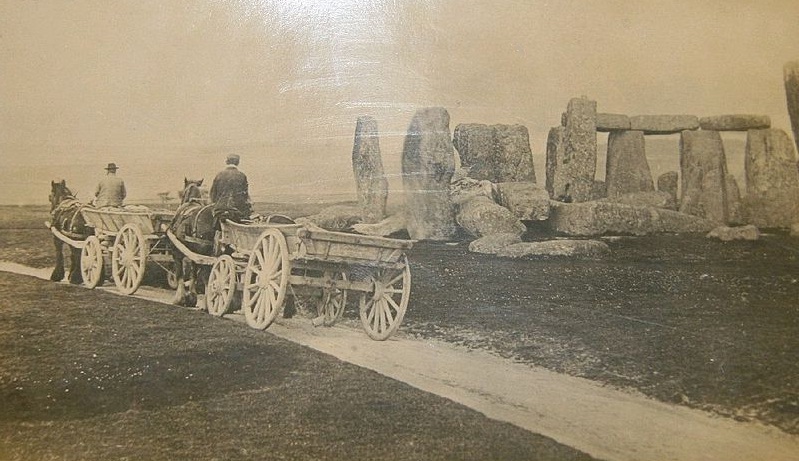
Found here:
Link (yeah I know, it's Wikipedia)
Then I checked National Geographic, and they confirm the Stonehenge rehabilitation
NatGeo
So it looks to me that it's not some big elaborate hoax. I think they should have just left it as it was, but no use crying over spilled milk.
From a little bit of research, less than 5 minutes worth. I found this image taken of Stonehenge from around 1885.

Found here:
Link (yeah I know, it's Wikipedia)
Then I checked National Geographic, and they confirm the Stonehenge rehabilitation
NatGeo
So it looks to me that it's not some big elaborate hoax. I think they should have just left it as it was, but no use crying over spilled milk.
Personally, I didn't know about this.
Thanks op! Very fascinating, makes you wonder if they made any changes that we don't know about...
Peace!
Thanks op! Very fascinating, makes you wonder if they made any changes that we don't know about...
Peace!
reply to post by skyblueworld
The first picture is not the site of Stonehenge.
The 1885 image shows it as it was. All they did was tidy it up and put what stones they could find back where they belonged during the face lifts.
It was never an empty site like that first picture suggests.
It is also a complete fabrication that the military were in any way involved in the face lift process. That myth stems from the fact that the military did own that area of Salisbury Plain where Stonehenge is situated.
Here in Cornwall where I live there are lots of stone circles and other monuments. I live only minutes away from quite a few. They are very atmospheric and are on the moors. It's lovely when its misty and you visit these.
For me there is a darkness about them because there were animal and human sacrifices happening over centuries at these places. It was the centre point of their religious practises, as it was with the worshippers of Baal and Moloch in the Middle East. Humanity was very brutal; still is when you consider...
The first picture is not the site of Stonehenge.
The 1885 image shows it as it was. All they did was tidy it up and put what stones they could find back where they belonged during the face lifts.
It was never an empty site like that first picture suggests.
It is also a complete fabrication that the military were in any way involved in the face lift process. That myth stems from the fact that the military did own that area of Salisbury Plain where Stonehenge is situated.
Here in Cornwall where I live there are lots of stone circles and other monuments. I live only minutes away from quite a few. They are very atmospheric and are on the moors. It's lovely when its misty and you visit these.
For me there is a darkness about them because there were animal and human sacrifices happening over centuries at these places. It was the centre point of their religious practises, as it was with the worshippers of Baal and Moloch in the Middle East. Humanity was very brutal; still is when you consider...
So, stonehenge may actually be assembled wrong. It was the interpretation of the archeologists that were overseeing the project as to what they
thought it should look like. It may have been a different configuration all together as far as we know.
The shape they chose may have been to make it look more of a attraction to tourists to bring money into the country. It's still impressive that the ancient people hauled those stones there and set them up anyway, even if they may be set up wrong.
The shape they chose may have been to make it look more of a attraction to tourists to bring money into the country. It's still impressive that the ancient people hauled those stones there and set them up anyway, even if they may be set up wrong.
reply to post by skyblueworld

Here is one at a place called Ding Dong on the Penwith Moors. I mountain bike here sometimes.
The feeling and awe of the ancient structures is quite something. Remember they are older than the Egyptian Pyramids in many cases.

Here is one at a place called Ding Dong on the Penwith Moors. I mountain bike here sometimes.
The feeling and awe of the ancient structures is quite something. Remember they are older than the Egyptian Pyramids in many cases.
edit on
21-12-2013 by Revolution9 because: wrong bit.
rickymouse
So, stonehenge may actually be assembled wrong. It was the interpretation of the archeologists that were overseeing the project as to what they thought it should look like. It may have been a different configuration all together as far as we know.
The shape they chose may have been to make it look more of a attraction to tourists to bring money into the country. It's still impressive that the ancient people hauled those stones there and set them up anyway, even if they may be set up wrong.
I don't at all know about assembled wrong Ricky. But If I was getting the job of rebuilding a granite astrolabe, the four food groups would keep ME up at night with the details.
Geometry
Astronomy/Astrology
Mathematics
real history (we gotta have some veggies with our meat and potatoes)
Really cool they'd decide to take that on though.
edit on 21-12-2013 by derfreebie because: Typocal for a Saturnday morning
The Greeks are rebuilding the Parthenon, so why not have the Brits 'repair' one of their historical treasures ? better than it totally falls apart
like so many other sites in the world, Ankor Watt springs to mind, and the taliban blowing up statues of Buddha.
The oldest known depiction of Stonehenge
Lucas Deheere 1573-75 I myself have drawn them on the spot British Library Add MS 28330, fol 36
1440? Corpus Christi College MS 194, fol 57
"That year Merlin, not by force but by art, brought and erected the giants' round from Ireland, at Stonehenge near Amesbury". 1440 Douai manuscript Scala Mundi
Folio 30r of British Library, Egerton 3028, a manuscript of English chronicles including an abreviated version the Brut by Wace. This illustration shows the construction of Stonehenge with the assistance of Merlin and is the oldest known illustration of Stonehenge. 1338 -40
British Archaeology
The foundation myth appears in the 12th century. Stonehenge, or Stanenges, is first briefly mentioned c1130 in Historia Anglorum, written by the archdeacon of Lincoln, Henry of Huntingdon, at the command of his bishop Alexander of Blois. "Noone can work out", says Henry, "how the stones were so skilfully lifted up to such a height or why they were erected".
Shortly after, around 1136, Geoffrey of Monmouth wrote his Historia Regum Britanniae, drawing on a vast range of material, from the Venerable Bede to British and continental legends, to build a history of the British kings from the Trojan Brutus up to the 7th century. The immense success of his much copied text shows the deep interest it rapidly inspired.
The passage concerning Stonehenge has often been described, and is well elaborated in Chippindale's Stonehenge Complete (Thames & Hudson, 3rd ed 2004). The legitimate British king, Aurelius Ambrosius, is in exile in Brittany while his usurper Vortigern allies himself with the invading Saxon king Hengist.
Vortigern and Hengist arrange a peace meeting at the "cloister of Ambrius" (Amesbury), but the Saxons treacherously slay 460 British lords. Aurelius returns, defeats both Vortigern and Hengist, and seeks a memorial to the dead. Merlin recommends the chorea gigantum, a stone monument on the Irish Mount Killaraus. Only his magic, however, can bring the stones to Amesbury, and he reconstructs them exactly as they were in Ireland. The text shows Aurelius's coronation in c480 and the erection of Stonehenge c485. Later Aurelius and his brother Uther Pendragon (father of Arthur) are buried at Stonehenge.
skinnersroomfiveyears.blogspot.com...
3.bp.blogspot.com...
Early sketch of Stonehenge found
static.guim.co.uk...
The oldest detailed drawing of Stonehenge, found in a 1440 manuscript, the Scala Mundi
They got the date wrong by some 3,000 years, but the oldest detailed drawing of Stonehenge, apparently based on first hand observation, has turned up in a 15th century manuscript.
The little sketch is a bird's eye view of the stones, and shows the great trilithons, the biggest stones in the monument, each made of two pillars capped with a third stone lintel, which stand in a horseshoe in the centre of the circle. Only three are now standing, but the drawing, found in Douai, northern France, suggests that in the 15th century four of the original five survived.
In the Scala Mundi, the Chronicle of the World, Merlin is given credit for building Stonehenge between 480 and 486, when the Latin text says he "not by force, but by art, brought and erected the giant's ring from Ireland". Modern science suggests that the stones went up from 2,500 BC, with the bluestone outer circle somehow transported from west Wales, and the double decker bus-size sarsen stones dragged 30 miles across Salisbury plain.
The drawing, recently identified by the art historian Christian Heck, has never been exhibited, but according to the Art Newspaper it will be seen next year in an exhibition at the Royal Academy in London, marking the 300th anniversary of the Society of Antiquaries.
There are two earlier images of Stonehenge, one in the British Library and one in the Parker Library in Cambridge, but the Douai drawing is unique in attempting to show how the monument was built.
It correctly shows tenon joints piercing the lintel, a timber construction technique, although in fact the real Stonehenge tenons only go partly into the top stone.
Stonehenge is rare among prehistoric landscapes, because its sheer bulk meant it was never lost. An Anglo Saxon poet wondered about the origin of the stones and inspired some of the earliest photographs.
www.theguardian.com...
edit on 21-12-2013 by IAMTAT because: (no reason given)
edit on
21-12-2013 by IAMTAT because: (no reason given)
this is as much about Stonehenge...as it is about the modern Druids that celebrate there
this link has only 4 pics
Winter solstice celebrated at Stonehenge
link: www.itv.com...
i celebrate solstice a lot different than these folks...
i will burn some pine needles and pine-cones at noontime here (east coast USA)
enjoy
this link has only 4 pics
Winter solstice celebrated at Stonehenge
People have once again been allowed access to the ancient stones of Stonehenge to mark sunrise on the winter solstice - the shortest day of the year. ....
link: www.itv.com...
i celebrate solstice a lot different than these folks...
i will burn some pine needles and pine-cones at noontime here (east coast USA)
enjoy
reply to post by rickymouse
No it isn't assembled "wrong" - most of the stones were as they are now, but with some of them having toppled. It is relatively easy to see how they fit together from markings, shape etc, much like fossils are put back together..
As for the restorations, as some have said it is hardly a secret and had sod all to do with the military. Not really sure what the OP's point is.
No it isn't assembled "wrong" - most of the stones were as they are now, but with some of them having toppled. It is relatively easy to see how they fit together from markings, shape etc, much like fossils are put back together..
As for the restorations, as some have said it is hardly a secret and had sod all to do with the military. Not really sure what the OP's point is.
derfreebie
rickymouse
So, stonehenge may actually be assembled wrong. It was the interpretation of the archeologists that were overseeing the project as to what they thought it should look like. It may have been a different configuration all together as far as we know.
The shape they chose may have been to make it look more of a attraction to tourists to bring money into the country. It's still impressive that the ancient people hauled those stones there and set them up anyway, even if they may be set up wrong.
I don't at all know about assembled wrong Ricky. But If I was getting the job of rebuilding a granite astrolabe, the four food groups would keep ME up at night with the details.
Geometry
Astronomy/Astrology
Mathematics
real history (we gotta have some veggies with our meat and potatoes)
Really cool they'd decide to take that on though.edit on 21-12-2013 by derfreebie because: Typocal for a Saturnday morning
Geometry
Astronomy/Astrology
Mathematics
real history
None of these necessarily needed to be in place when they originally stacked the stone. Maybe they just hauled a bunch of rock and stacked or stood it up back then. Maybe Astrology wasn't really a big thing to everyone back then, maybe they just wanted a cool place to go to. If there was music there, it would have been called a rock concert.
edit on 21-12-2013 by rickymouse because: (no reason given)
some of the temples in egypt had to be moved so the sun ligned up on the solstice and i remember reading this about stonehenge that it had been
shifted back in pre history as the world had moved on its axis in -752 bc .
in 1750 the sun was well out of alignment someone had taken their eye of the ball so that on the 22-23 24 of december as the christians say the sun of god did not die for 3 days or the sun did not move backwards for 3 days so they added 12 days to the callender look it up british callender act .
after the jacobite uprising in 1745 english troops devastated just about all stone circles in scotland and their were many just like all the pyramids that vanished in egypt in the 17 th and 18th centuarys .
i remember reading that they found a skeleton buried under one of the stones with 3 coins on it ?
in 1750 the sun was well out of alignment someone had taken their eye of the ball so that on the 22-23 24 of december as the christians say the sun of god did not die for 3 days or the sun did not move backwards for 3 days so they added 12 days to the callender look it up british callender act .
after the jacobite uprising in 1745 english troops devastated just about all stone circles in scotland and their were many just like all the pyramids that vanished in egypt in the 17 th and 18th centuarys .
i remember reading that they found a skeleton buried under one of the stones with 3 coins on it ?
geobro
some of the temples in egypt had to be moved so the sun ligned up on the solstice and i remember reading this about stonehenge that it had been shifted back in pre history as the world had moved on its axis in -752 bc .
Erm, no it didn't. You're getting confused - the earth's axial tilt changes constantly, over the course of 27,000 years or so - it doesn't do it in great leaps, but rather gradually over many centuries. That would explain any "misalignment". It's call precession
geobro
in 1750 the sun was well out of alignment someone had taken their eye of the ball so that on the 22-23 24 of december as the christians say the sun of god did not die for 3 days or the sun did not move backwards for 3 days so they added 12 days to the callender look it up british callender act .
Again, quite, quite wrong. The reason for any calendar changes, be it in modern times or in fact in Roman times, was because they had either been based on a lunar cycle (28 days per month) and ended up with the months being wrong for the seasons over many centuries, or they had calculated the length of the day/year wrong in the first place.
As for your bit about the "sun not dying for 3 days" or it just hanging in the air, this would have nothing to do with any Calendar, not that it ever happened at all.
geobro
after the jacobite uprising in 1745 english troops devastated just about all stone circles in scotland and their were many just like all the pyramids that vanished in egypt in the 17 th and 18th centuarys .
Did they really? Someone had better tell Tourism Scotland then, because they are quite proud of their stone circles, promote visiting the many they have and I can't seem to find any reference of a systematic, targeted campaign by "English" troops.
Actually, the Jacobite rebellion wasn't as simple as English vs Scots as a good many English fought for the Jacobite's in the early years. It is also worth noting that a great many Scottish forces loyal to the Government fought against the Jacobite's as well, so it is very, very simplistic (ignorant?) for you to declare them "English".
geobro
i remember reading that they found a skeleton buried under one of the stones with 3 coins on it ?
Yeah, people always "remember" stuff - link?
Not that I would think it odd anyway, as there are a good many bronze age burial mounds in the area and it stands to reason some will be found close to the site.
Now when did Samuel Pepys write his great diary, seem to remember he reports on the Great Fire of London, 1666 I think?
Some where in his diary he refers to taking a "Holiday trip" in the South West of England ...one of the places he mentions is......yep you guessed it:-
Stonehenge. (Stonage)
"In the afternoon come to Abebury, where, seeing great stones like those of Stonage standing up," June 1668
www.pepys.info...
I think his account is probably true, so looks like it was standing, or fallen down, sometime before 1900. He also mentions the Avebury site as being greater.
Think what you are looking at is when the some of the stones were re-erected in their existing holes and the cap stones were re-installed in the correct place.
The Victorians made extensive surveys and drawings of the stones.
Some where in his diary he refers to taking a "Holiday trip" in the South West of England ...one of the places he mentions is......yep you guessed it:-
Stonehenge. (Stonage)
"In the afternoon come to Abebury, where, seeing great stones like those of Stonage standing up," June 1668
www.pepys.info...
I think his account is probably true, so looks like it was standing, or fallen down, sometime before 1900. He also mentions the Avebury site as being greater.
Think what you are looking at is when the some of the stones were re-erected in their existing holes and the cap stones were re-installed in the correct place.
The Victorians made extensive surveys and drawings of the stones.
Heya OP! I guess a bunch of folks here had heard about this a long time ago but I for one had never heard a peep about the fact Stonehenge isn't
ruins as they sit, but a man made facsimile of what the ruins once may have been or been meant to be or HAD been before falling into some serious
disrepair.
For some reason, I thought the aged and semi-collapsed appearance was authentic.
Authentic....that word just doesn't mean anything anymore until we have done personal research to make sure something wasn't re-done and simply not mentioned as something in the public awareness.
For some reason, I thought the aged and semi-collapsed appearance was authentic.
Authentic....that word just doesn't mean anything anymore until we have done personal research to make sure something wasn't re-done and simply not mentioned as something in the public awareness.
new topics
-
RFK is Trumps health pick
2024 Elections: 2 hours ago -
Thanksgiving 2024
Member Art: 8 hours ago -
The art of being offended
Social Issues and Civil Unrest: 10 hours ago -
FLORIDA Sues Biden-Harris FEMA for Denying Disaster Assistance to Homeowners with TRUMP Signs.
US Political Madness: 10 hours ago
top topics
-
Turns out, they planned to go after P-nut.
US Political Madness: 14 hours ago, 21 flags -
The art of being offended
Social Issues and Civil Unrest: 10 hours ago, 18 flags -
FLORIDA Sues Biden-Harris FEMA for Denying Disaster Assistance to Homeowners with TRUMP Signs.
US Political Madness: 10 hours ago, 13 flags -
Thanksgiving 2024
Member Art: 8 hours ago, 10 flags -
RFK is Trumps health pick
2024 Elections: 2 hours ago, 10 flags
active topics
-
-@TH3WH17ERABB17- -Q- ---TIME TO SHOW THE WORLD--- -Part- --44--
Dissecting Disinformation • 3269 • : RelSciHistItSufi -
RFK is Trumps health pick
2024 Elections • 3 • : putnam6 -
President-Elect DONALD TRUMP's 2nd-Term Administration Takes Shape.
Political Ideology • 190 • : WeMustCare -
Mike Tyson returns 11-15-24
World Sports • 29 • : ByeByeAmericanPie -
WATCH LIVE: US Congress hearing on UFOs, unidentified anomalous phenomena
Aliens and UFOs • 54 • : putnam6 -
Comcast dumping MSNBC
Mainstream News • 26 • : WeMustCare -
President-elect TRUMP Picks MATT GAETZ for his ATTORNEY GENERAL - High Level PANIC Ensues.
2024 Elections • 71 • : WeMustCare -
Kamala Harris tells Oprah she will kill an intruder
US Political Madness • 43 • : WeMustCare -
Elon's Starlink Stole The Election For Trump--Leftist Conspiracy Theorists Charge
General Conspiracies • 44 • : DdPoolDude -
Encouraging News Media to be MAGA-PAF Should Be a Top Priority for Trump Admin 2025-2029.
Education and Media • 69 • : WeMustCare
